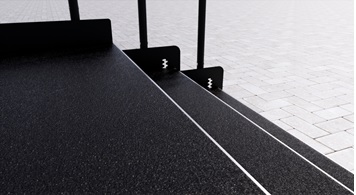
Published on Tuesday 18th February 2020
The Equality Act 2010 replaced the Disability Discrimination Act 2005 (DDA). However, the term ‘DDA-compliant ramp’ is still widely used when referring to regulations that ensure disabled people have the right to access buildings, services, and public spaces.
The Equality Act 2010 replaced the Disability Discrimination Act 2005 (DDA). However, the term ‘DDA-compliant ramp’ is still widely used when referring to regulations that ensure disabled people have the right to access buildings, services, and public spaces.
What does the Equality Act cover?
The Equality Act 2010 protects individuals from discrimination on the grounds of (including but not limited to):
- Disability
- Age
- Gender
- Race
- Religion
- Sexual orientation
The Rights of Disabled People under The Equalities Act
Under the Equality Act, employers, local authorities, schools, and service providers are required to make reasonable adjustments to remove barriers that may prevent disabled individuals from accessing employment, education, or essential services. Find out more about these requirements here.
Physical barriers
Common physical barriers include:
- Steps, stairways, kerbs, and uneven surfaces
- Parking areas and building entrances/exits (including emergency routes)
- Doors, gates, lifts, escalators, and ventilation
- Toilets, washing facilities, and public service areas (e.g. counters or telephones)
- Floor coverings, lighting, furniture, and temporary obstacles such as display racks
What is considered reasonable disabled access?
The requirements for reasonable disabled access depend on the type of building being assessed.
Private Dwellings
To ensure a home meets DDA compliance, any installed ramp must adhere to the specific regulations governing residential accessibility.

Public Buildings
When constructing or refurbishing public buildings, it is crucial to provide high-quality DDA-compliant access.
All permanent and semi-permanent access solutions, including wheelchair ramps and steps, must fully comply with the Disability Act and the standards outlined in Documents M and K of the Building Regulations.
.jpg)

Temporary Buildings
Ramps and steps for temporary public buildings must comply with the Documents M and K of the Buildings Regulations.
Additional Safety Features
Extras are available with our modular wheelchair ramps and steps, including:
- Infill Handrails - prevents users from climbing or falling through gaps.

- Yellow Tread - A safety feature designed to help those with impaired vision identify the nose of the ramp or step. Additionally, it helps users distinguish any level changes.

- GRP Platform - A slip-resistant and non-corrosive surface that is ideal for areas with high footfall such as schools and public spaces. The product comes in dark grey as standard.

- Standard Underside Mesh - This is designed to prevent children from gaining access to the underneath of the ramp.

Request A Quick Quote For A DDA Ramp
Quotations can be returned within 24hrs if there is clear information given, including project address, drawings, photos and contact details.
Sources:
Crown and database, Equality Act 2010, legislation.gov.uk (https://www.legislation.gov.uk/ukpga/2010/15/contents)
Crown, 2021, The Building Regulations, Approved Document M: access to and use of buildings, volume 2: buildings other than dwellings (https://assets.publishing.service.gov.uk/media/60b0ea89d3bf7f43560e324a/Approved_Document_M_vol_2.pdf)
Crown, 2013, The Building Regulations 2010, Approved Document K: protection from falling, collision and impact (https://assets.publishing.service.gov.uk/media/60d5bdcde90e07716f516cfd/Approved_Document_K.pdf)
THE UK’S EXPERTS IN MODULAR RAMP SYSTEMS.
Rapid Ramp
Riverside Works, Church Ln, Etchingham, TN19 7AS
Hours:
8am - 5pm, Monday to Friday
